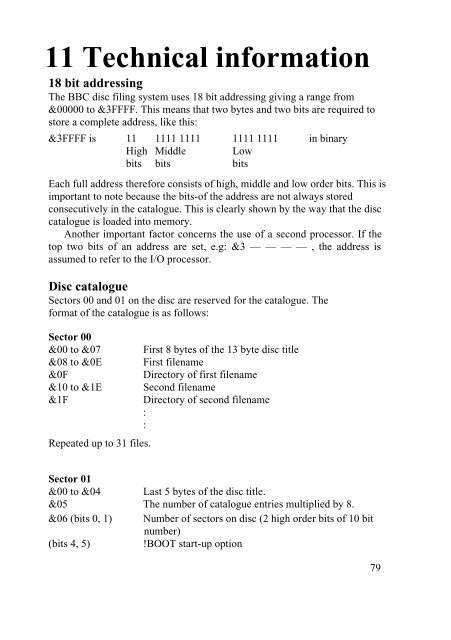Create successful ePaper yourself
Turn your PDF publications into a flip-book with our unique Google optimized e-Paper software.
11 Technical information<br />
18 bit addressing<br />
The BBC disc filing system uses 18 bit addressing giving a range from<br />
&00000 to &3FFFF. This means that two bytes and two bits are required to<br />
store a complete address, like this:<br />
&3FFFF is 11 1111 1111 1111 1111 in binary<br />
High Middle Low<br />
bits bits bits<br />
Each full address therefore consists of high, middle and low order bits. This is<br />
important to note because the bits-of the address are not always stored<br />
consecutively in the catalogue. This is clearly shown by the way that the disc<br />
catalogue is loaded into memory.<br />
Another important factor concerns the use of a second processor. If the<br />
top two bits of an address are set, e.g: &3 — — — — , the address is<br />
assumed to refer to the I/O processor.<br />
<strong>Disc</strong> catalogue<br />
Sectors 00 and 01 on the disc are reserved for the catalogue. The<br />
format of the catalogue is as follows:<br />
Sector 00<br />
&00 to &07 First 8 bytes of the 13 byte disc title<br />
&08 to &0E First filename<br />
&0F Directory of first filename<br />
&10 to &1E Second filename<br />
&1F Directory of second filename<br />
:<br />
:<br />
Repeated up to 31 files.<br />
Sector 01<br />
&00 to &04 Last 5 bytes of the disc title.<br />
&05 The number of catalogue entries multiplied by 8.<br />
&06 (bits 0, 1) Number of sectors on disc (2 high order bits of 10 bit<br />
number)<br />
(bits 4, 5) !BOOT start-up option<br />
79
















